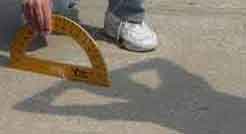Who May Participate?
While the measurement activity may be more appropriate
for students in upper elementary through high school grades, students of lower
elementary grades could observe how a shadow changes direction and length
throughout the day. And by comparing pictures of the mid-day shadow at various
locations these students could see, at the least, that where one lives has an
effect on the 'behavior' of a shadow during the daylight hours.

Earn a Certificate.
To receive a certificate of participation, be sure to
complete the online data report form.
Where Does the Certificate Come From?
The certificate is from an article written by
Brian Poelker, a science teacher at Midwest Central Middle School in Green
Valley, Illinois. All certificates will be mailed from Brian's school as soon as
possible.
Brian is the author of 22 journal articles and
contributor to a dozen science education books and textbooks. He has been long been
an advocate of school collaborative projects and the use of technology. Among
his many awards and acknowledgments Brian was an Illinois delegate to
The Teachers Vision of the Future of Education - A Challenge to the Nation.
As a result of that conference he was a member of the team that presented
"Telecommunications in the Classroom" at the First National Teachers Summit in Miami,
which featured Brian's use of the then infant Internet to link schools in a project
to measure the circumference of the earth.
Poelker, Brian. "Eratosthenes Updated: A Grecian Formula for Measuring
the Earth". 1993, Vol.16, No.6, pp.18-19. Science Scope Magazine.
National Science Teachers Association.
How To Participate?
Download the SunShIP Data Sheet from the Links page. Read over those directions,
and make preparations for the project by completing all of the Data Sheet except
for what will be determined on the equinox day.
Also read the information about the project on the SunShIP web site.
Practice measuring the Sun's altitude using either a shadow stick or a
student casting the shadow. (Be sure to use a flat surface and hold the shadow stick
as straight up as possible.)
A more accurate measurement can be made by having several teams or individuals
measure the Sun's altitude at the same time, and then use the average altitude from
those doing that particular measurement.
Use the online form to submit the information requested.

Measure the Sun's Altitude
Using the Data Sheet.
Click on this link to see directions for using a
shadow stick or pencil to draw a triangle to measure the Sun's altitude.

Primary Grade Students Observe Shadow Changes.
Click on this link to see some directions
for having primary grade students observe how their shadow changes during the day.

Measure the Sun's Altitude
Using A Student as the 'Stick'.
Click on this link to see directions for using a
a student-cast shadow to measure the Sun's altitude.
What Are We Looking For?
We are looking for observational measurement
data of the altitude of the mid-day Sun from various latitudes, and pictures of
shadows from different latitudes to illustrate how latitude affects the height
of the mid-day Sun.
This will be posted on the project web site.
What Is Mid-day?
Mid-day is the time when the Sun is halfway between
the time of sunrise and the time of sunset. At this time the Sun will be at its highest
above the horizon - its maximum altitude. at mid-day in the northern hemisphere,
the Sun is over the southern horizon, while in the southern hemisphere the Sun
is over the northern horizon at mid-day.
Exactly When Is The September Equinox?
Using Universal Time, the equinox occurs at 1630 UT, 22 September.
Also on this date Jupiter is in conjunction with the Sun, our Moon is at perigee,
and the variable star Algol in Perseus is at its minimum.
What Is Universal Time?
Universal Time, UT, is essentially what many of us
learned as Greenwich Mean Time. Universal Time is based on the prime Meridian. Your
local time and the difference between your local time and UT is based on how many
degrees longitude you are from the prime meridian, 0 degrees. West longitude is
earlier so you would subtract 1 hour from UT for every time zone west
until you reach the International Date Line at 180 degrees West. East longitude
is later so you would add 1 hour for each time zone you are east of the prime
meridian until you reach the International Date Line.
For example I live in Lee's Summit Missouri at 94
degrees west longitude. Each time zone is 15 degrees wide and represents
approximately 1 hour of Earth rotation. By dividing 94 by 15 I find that I am
6 time zones, or 6 hours of Earth rotation, away from the prime meridian.
Specifically I am an additional 4 degrees west, 16 minutes of Earth rotation,
from the central meridian, 90 degrees for my time zone - Central Time.
It is easy to convert from UT to either your time zone
time, or your local time based on your longitude. For example the September
equinox occurs at 1630 UT or by subtracting the six-hour difference, 1030 Central
Time, or 1014 my local time.
However, one thing to remember when converting is to
allow for being on either Daylight Saving Time, or Standard Time. The 6-hour difference
is while on standard time. In the United States we 'spring forward' 1 hour to
Daylight Saving Time between April and September. This means
that the time difference between UT and local time decreases by 1 hour, to a five
hour difference instead of six. So actually the September equinox, for me, occurs
at 1130 CDT, or 1114 local time at 94 degrees west longitude.
Why Do You Say The September Equinox?
I learned and adopted this expression into personal use
from a friend and colleague, Katherine Becker. Although it is the accepted term,
Katherine correctly pointed out that it was unfair to the folks in the southern
hemisphere for one to say, for example, 'Autumnal Equinox' as it would be the opposite season
in the southern hemisphere, spring.
I still use equinox and solstice however they are now
prefaced with the name of the month they occur in: March equinox; June Solstice;
September equinox; and December solstice. And if I didn't, I would have either
Katherine or Eric after me!

























